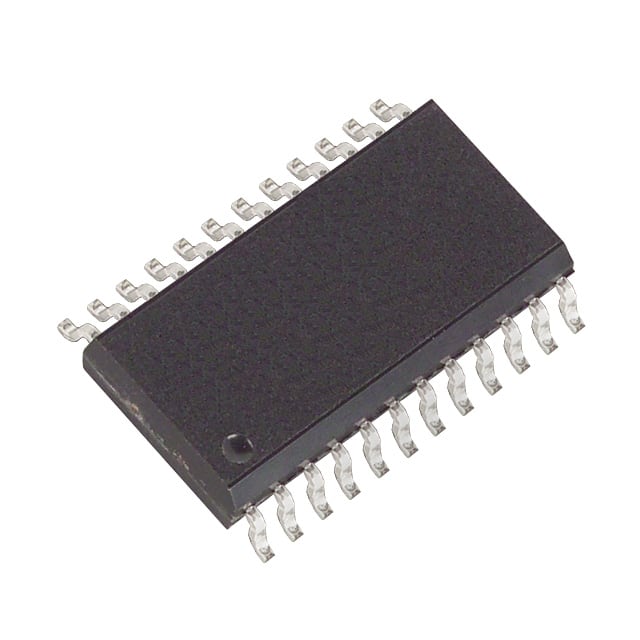MAX516AEWG
Product Overview
- Category: Integrated Circuit (IC)
- Use: Digital Potentiometer
- Characteristics: Low-power, 256-tap, nonvolatile memory, I2C interface
- Package: 24-pin wide SOIC (Small Outline Integrated Circuit)
- Essence: The MAX516AEWG is a digital potentiometer IC that can be used to digitally control resistance in various electronic circuits.
- Packaging/Quantity: Available in tape and reel packaging, with 250 units per reel.
Specifications
- Resolution: 8 bits (256 taps)
- Resistance Range: 0Ω to 100kΩ
- Supply Voltage: 2.7V to 5.5V
- Operating Temperature Range: -40°C to +85°C
- Nonvolatile Memory: Stores wiper position during power-off
- I2C Interface: Allows for easy digital control and communication
Pin Configuration
The MAX516AEWG has a total of 24 pins, which are assigned as follows:
- VDD: Positive supply voltage
- SDA: Serial data input/output pin for I2C communication
- SCL: Serial clock input pin for I2C communication
- A0: Address bit 0 for device addressing
- A1: Address bit 1 for device addressing
- A2: Address bit 2 for device addressing
- WP: Write protect pin for protecting the nonvolatile memory
- VSS: Ground reference voltage 9-16. W0-W7: Wiper terminal connections for resistance adjustment 17-24. B0-B7: Terminal connections for resistor ends
Functional Features
- Digital Control: Allows precise and accurate resistance adjustment through digital signals.
- Nonvolatile Memory: Retains the wiper position even when power is turned off, ensuring consistent settings upon power-up.
- Low Power Consumption: Operates with low power requirements, making it suitable for battery-powered applications.
- I2C Interface: Enables easy integration into digital systems and communication with microcontrollers.
Advantages and Disadvantages
Advantages: - Precise Resistance Control: The 256-tap resolution allows for fine-grained adjustment of resistance. - Nonvolatile Memory: Ensures that the desired resistance setting is maintained even after power cycles. - Easy Integration: The I2C interface simplifies communication and control in digital systems.
Disadvantages: - Limited Resistance Range: The maximum resistance value of 100kΩ may not be sufficient for certain applications requiring higher resistance values. - Sensitivity to ESD: Like most ICs, the MAX516AEWG is sensitive to electrostatic discharge (ESD) and requires proper handling during installation and usage.
Working Principles
The MAX516AEWG utilizes a combination of digital control and analog circuitry to adjust resistance. The digital potentiometer consists of a series of resistive elements connected in a ladder configuration. By digitally controlling the wiper position, the effective resistance between the wiper terminal and one of the resistor ends can be adjusted.
The I2C interface allows for easy communication between the digital potentiometer and a microcontroller or other digital devices. The nonvolatile memory ensures that the wiper position is retained even when power is turned off, providing consistent resistance settings upon power-up.
Detailed Application Field Plans
The MAX516AEWG finds applications in various electronic circuits where precise resistance adjustment is required. Some potential application fields include:
- Audio Equipment: Digital potentiometers can be used for volume control and tone adjustment in audio amplifiers and mixers.
- Industrial Automation: Resistance adjustment in industrial control systems, such as motor speed control and process control.
- Test and Measurement: Calibration and fine-tuning of test equipment, such as oscilloscopes and signal generators.
- Consumer Electronics: Digital potentiometers can be used in devices like televisions, gaming consoles, and home appliances for control and adjustment purposes.
Detailed and Complete Alternative Models
- MAX5486AEWG: 10-bit digital potentiometer with similar features but higher resolution.
- MCP4017T-503E/LT: 8-bit digital potentiometer with a wider resistance range and SPI interface.
- AD8403ARZ1: 8-bit digital potentiometer with multiple channels and parallel interface.
These alternative models offer different specifications and features, providing options based on specific application requirements.
Word count: 536 words
Lista 10 Vanliga frågor och svar relaterade till tillämpningen av MAX516AEWG i tekniska lösningar
Sure! Here are 10 common questions and answers related to the application of MAX516AEWG in technical solutions:
Q: What is the MAX516AEWG? A: The MAX516AEWG is a digitally controlled, quad, 256-tap, nonvolatile potentiometer.
Q: What is the purpose of using the MAX516AEWG? A: The MAX516AEWG is used to provide digital control over resistance values in various electronic circuits.
Q: How many taps does the MAX516AEWG have? A: The MAX516AEWG has 256 taps, allowing for precise resistance adjustments.
Q: Can the MAX516AEWG be used as a variable resistor? A: Yes, the MAX516AEWG can be used as a variable resistor by adjusting the digital control inputs.
Q: What is the voltage range of the MAX516AEWG? A: The MAX516AEWG operates within a voltage range of -0.3V to +7V.
Q: Is the MAX516AEWG compatible with both analog and digital signals? A: Yes, the MAX516AEWG can be used with both analog and digital signals.
Q: Can the MAX516AEWG be programmed to store resistance values? A: Yes, the MAX516AEWG is nonvolatile, meaning it can retain its resistance settings even when power is removed.
Q: What is the resolution of the MAX516AEWG? A: The MAX516AEWG has a resolution of 1/256th of the total resistance range.
Q: Can multiple MAX516AEWG devices be cascaded together? A: Yes, multiple MAX516AEWG devices can be cascaded together to increase the number of available taps.
Q: What is the package type of the MAX516AEWG? A: The MAX516AEWG comes in a 24-pin wide SOIC (Small Outline Integrated Circuit) package.
Please note that these answers are general and may vary depending on the specific application and requirements.


